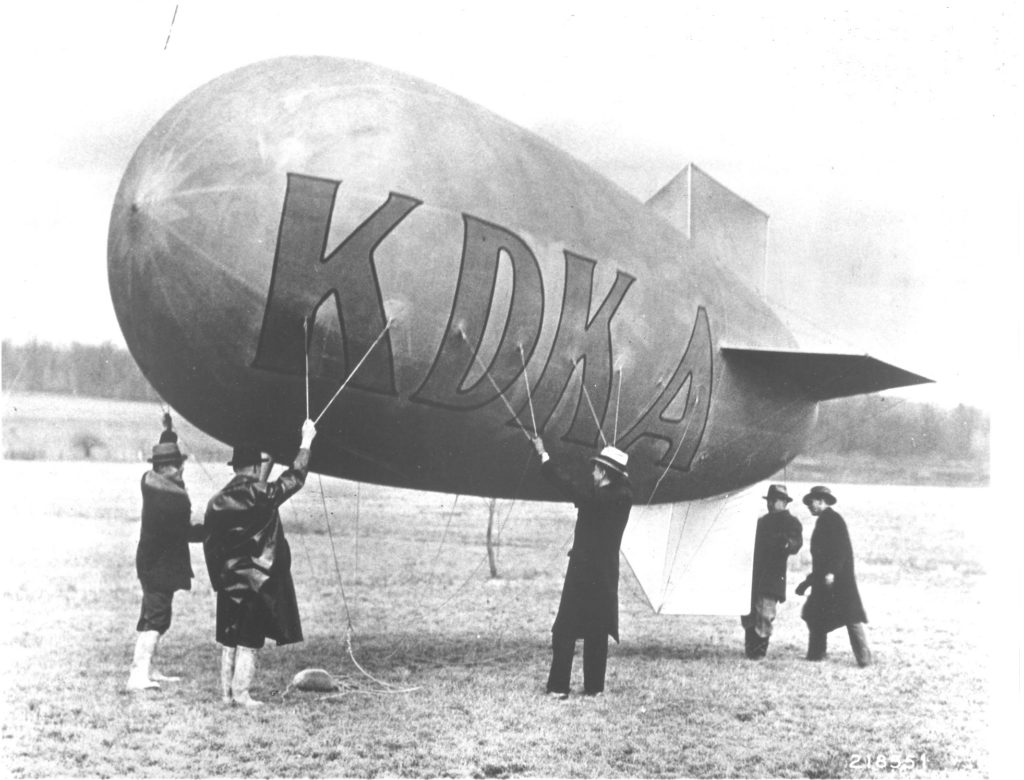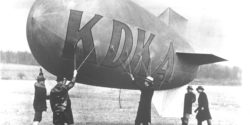If you are, like me, a total sucker for “one hundred years ago today” anniversary stories, you are going to love this decade when it comes to broadcast radio history. To be fair, the 20-teens had their moments, case in point the Radio Act of 1912. But that decade offered slim pickings compared to the 2020s.

The fun starts in 2020. Many anniversary journalists will focus on the launching of KDKA in Pittsburgh. “Its first broadcast,” write historians Christopher Sterling and John M. Kitross, “held on election night, November 2, 1920, came from a 100 watt transmitter in a tiny makeshift shack atop a Westinghouse manufacturing building.” The Pittsburgh Post fed election returns to the station via a telephone connection. KDKA broadcast the data “to an estimated few thousand listeners, including some people at a Pittsburgh country club, over Westinghouse-supplied speakers.”
Does this mean that KDKA had launched the “first broadcast by a licensed radio station”? I predict that the 2020s will not only see lots of anniversary “first” stories, but plenty of battles over who was really first.
Then there was (get out your hankies folks) the first broadcast radio commercial. The trade news site Campaign US notes that it aired on August 28, 1922 on a station owned by the AT&T corporation: WEAF in New York. The Queensboro Corporation paid for fifty minutes at the rate of a dollar per minute to extol the virtues of an apartment complex in Jackson Heights, Queens.
“Friend,” the sales pitch explained:
“you owe it to yourself and your family to leave the congested city and enjoy what nature intended you to enjoy. Visit our new apartment homes in Hawthorne Court, Jackson Heights, where you may enjoy community life in a friendly environment.”
1922 not only witnessed this heartwarming moment, but also the first worried speech about the potential impact of commercials on radio. Herbert Hoover read the first generation of broadcasters the riot act that year at the First National Radio Conference. “The wireless spoken word has one definite field,” Hoover proclaimed, “and that is for broadcast of certain predetermined material of public interest from central stations. . . .
This material must be limited to news, to education, and to entertainment, and the communication of such commercial matters as are of importance to large groups, of the community at the same time . . . It is therefore primarily a question of broadcasting, and it becomes of primary public interest to say who is to do the broadcasting, under what circumstances, and with what type of material. It is inconceivable that we should allow so great a possibility for service to be drowned in advertising chatter.”
“Inconceivable”? Isn’t that what Wallace Shawn said in The Princess Bride? Moving right along, on September 13, 1926, a duo of RCA executives announced the creation of the National Broadcasting Company.
Here is my favorite part of the statement:
“The Radio Corporation is not in any sense seeking a monopoly of the air. That would be a liability rather than an asset. It is seeking, however, to provide machinery which will insure a national distribution of national programs, and a wider distribution of programs of the highest quality.”
Fifteen years later the Federal Communications Commission concluded that, contrary to this assertion, NBC was, in fact, monopolizing the airwaves. In 1941 the agency issued its ban on “dual networks,” forcing the company to divest holdings that would eventually become the nation’s third network, the American Broadcasting Company.
Meanwhile at the same time that all this monopolizing took place, college radio spread across the USA. I wish that I could identify the first college radio station in the country, but as Jennifer Waits notes, it is not so easy. Still, candidates for the 1920s would include the University of Minnesota, Grove City College, the University of Wisconsin, the New Mexico College of Agriculture and Mechanic Arts, Haverford College, and Dartmouth.
Alas, no good deed goes unpunished. In 1927 the government appointed a regulator for broadcast radio: the Federal Radio Commission. The FRC repaid this decision with an Order that reorganized the nation’s radio licenses in favor of big commercial operations at the expense of smaller non-profit and college radio outfits. What happened? As I put it myself ten years ago:
“The result? In 1926 most stations belonged to civic groups, or colleges and universities, or trade unions. Only 4.3 percent were commercial stations. But by 1934 the vast majority of licenses were now commercially supported (98 percent). Early 1920s proposals like Secretary of Commerce Herbert Hoover’s to fund radio with a two percent tax on receivers were forgotten by all but a handful of media reform groups.”
I am sure that I have missed many wonderful bullet points in this timeline. And if for some reason (like preserving your sanity) you decide to skip the 2020s altogether, rest assured that the 2030s will offer one hundred year broadcast anniversaries galore, such as Orson Welles’ famous 1938 rendition of War of the Worlds, which scared the daylight out of America . . . or did it?
This article was edited on January 5, 2020; I suspect that it may be edited some more. Stay tuned.



